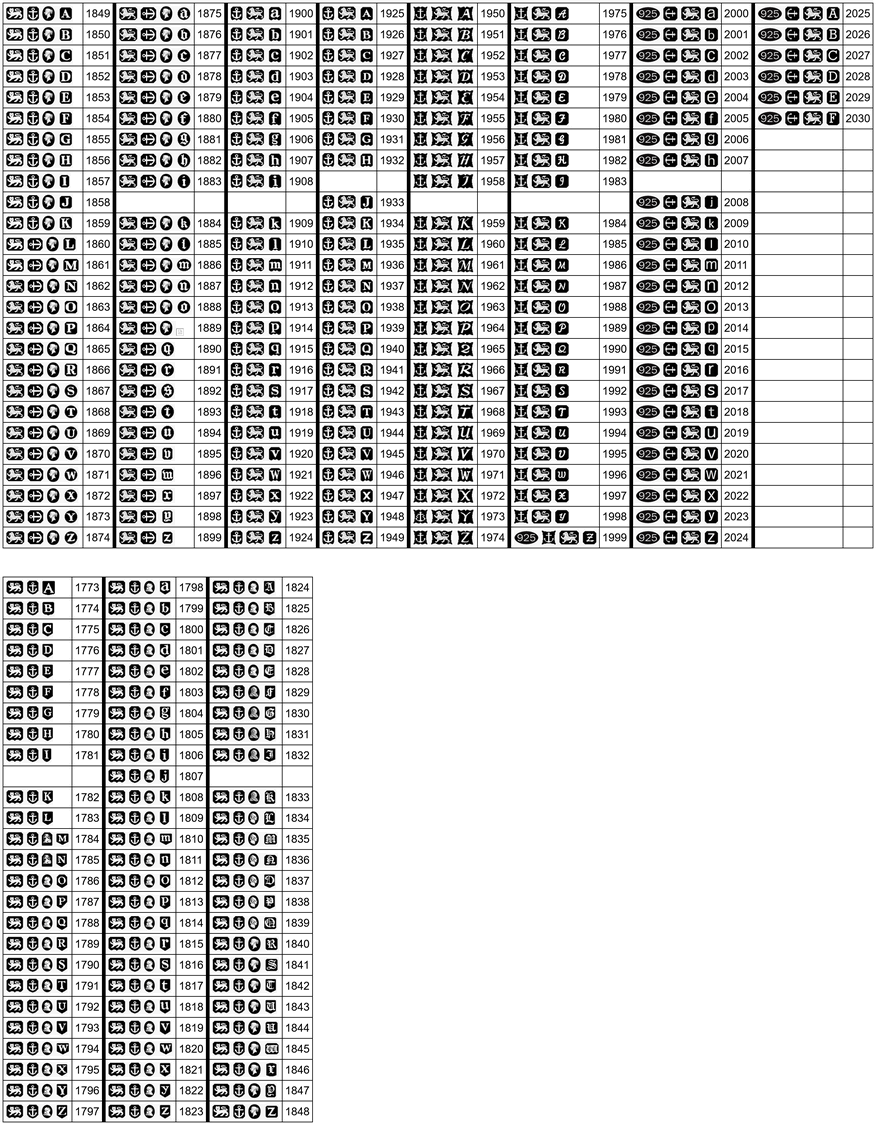- English UK Birmingham Assay Silver Marks ~ Hallmarks & Makers' Mark
- ChineseArgent: All Silver: Art, Antiques, Hallmark & Articles
- Birmingham Hallmarks 1 - Encyclopedia of Silver Marks, Hallmarks & Makers' Marks
English UK Birmingham Assay Silver Marks ~ Hallmarks & Makers' Mark
WH into two conjoined circles Walter Hands - possibly , Chester hallmark. H into an oval W M Hayes , Birmingham hallmark. H into a half oval William Harrison , Active in London: H into two conjoined circles William Harris -possibly-, Birmingham hallmark. WHC into an oval W.
This firm registered a mark in Chester in c. The firm was classified by Chester Assay Office as "Tabacconist and fancy goods dealers". Birmingham date not identified hallmark. W HE O into a rectangle not identified London hallmark. Howden, Edinburgh hallmark. WHL not identified , Exeter hallmark.
- Birmingham Date Letters.
- noodle dating;
- English silver hallmarks: British maker's marks identification WH-WL.
- MARK OF ORIGIN - TOWN MARK;
Mark entered Birmingham hallmark. T into a rectangle W. Twentyman , India c. Boulton lobbied Parliament vigorously and was finally rewarded by the Hallmarking Act , which founded the Birmingham Assay Office. Assay marking began in Birmingham in The date letter, which followed a 25 year cycle, was changed in July until when it along with all other British date letter sequences changed in January.

The Britannia figure was used in silver of Birmingham gained the right to assay gold and silver articles with the establishment of the Birmingham Assay Office in The Assay Office was established largely due to the efforts of Matthew Boulton. Thinking that these two symbols would make good hallmarks, they decided to toss a coin to see which town would get which mark. The Birmingham Assay Office was founded in , when the city and some of its most famous entrepreneurs were playing a leading role in the Industrial Revolution.
ChineseArgent: All Silver: Art, Antiques, Hallmark & Articles
At this time, silversmithing was booming in Birmingham, with manufacturers making buttons, buckles, spoons and other small articles. In , Matthew Boulton made a major investment in his family business, relocating it from Snow Hill to the purpose built Soho Manufactory in Handsworth, then just outside the Birmingham boundary.
- STANDARD MARK.
- Birmingham Hallmarks - Encyclopedia of Silver Marks, Hallmarks & Maker's Marks.
- dating and kissing games free online.
- remote start hook up;
- old man dating younger woman.
- Get an Amazing 25%, 50% or Even a Massive 80% off by Buying at Auctions.
The new factory employed over people, but Boulton soon discovered that having to send all his items to Chester Assay Office for Hallmarking was a serious handicap to his business. Apart from the expense and delay, those articles which did survive the perils of travelling 70 miles each way in horse-drawn carriages, over rutted roads frequented by highwaymen, were sometimes damaged by careless packing, or copied by the Chester silversmiths.
Boulton resolved to take action on behalf of all Birmingham silversmiths. He had staunch support from many local nobility, landed gentry and members of the royal family who were all satisfied customers. Quite how the decision was made is unclear, but it was probably the toss of a coin which determined that Birmingham, in the heart of the country and miles from the sea, should adopt the Anchor as its hallmarking symbol, whilst Sheffield took the Crown subsequently changed to the Rose.
Birmingham Hallmarks 1 - Encyclopedia of Silver Marks, Hallmarks & Makers' Marks
The first day of opening was 31st August and not surprisingly the first customer was Matthew Boulton. The Act of Parliament stipulated that the Office should be controlled by a Board of thirty-six Guardians of the Standard of Wrought Plate in Birmingham, of whom not more than nine nor less than six might be connected with the trade.
This was a departure from the older established office and halls, administered by the Guilds. The new Birmingham Assay Office was created to be self-supporting with all its revenues coming from charges for assaying or marking. Rapid industrial expansion provided great potential in the early years; by the Office had moved to premises in Little Cannon Street, and in moved again to its current site in Newhall St, complete with all its Victorian splendour.
